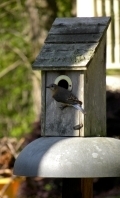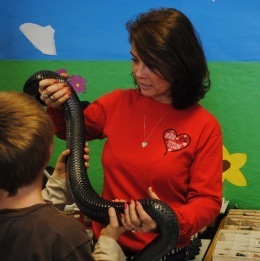Welcome to the new Georgia Wild
We've made the newsletter more compact and timely! You'll now receive Georgia Wild 22 times a year instead of 12, keeping you better informed about nongame wildlife statewide. Let us know what you think about the changes (email rick.lavender@dnr.state.ga.us). You can also plug into a new, expanded array of Wildlife Resources Division updates by email and text. Click the red envelope at www.georgiawildlife.org and follow the prompts to receive state outdoors news that interests you!

A chilling search for white-nose
DNR biologists check caves and bats, but find no disease
DNR wildlife biologists Trina Morris and Nikki Castleberry are a quarter-mile beneath untold tons of rock, smeared with mud and cold to the bone after sloshing for hours through a thigh-deep subterranean stream. Welcome to Georgia’s frontline against white-nose syndrome, where the work is sometimes miserable but ever vital.
The good news? “”We haven’t found bats in Georgia that look like they’re impacted by white-nose,” Morris says.
The bad: They won’t be surprised if they do. The disease that has killed an estimated 5.7 million to 6.7 million cave-dwelling bats from New England to the Midwest and into Canada, wiping out these airborne insect terminators at many hibernacula or overwintering sites, has been documented as close as Tennessee and North Carolina.
Earlier this month, Morris and Castleberry completed winter checks for white-nose’s tell-tale signs – a mold-like fuzz on the muzzle and wings, and ragged wing membranes – with a trek deep into Sitton’s Cave at Cloudland Canyon State Park. Helped by veteran caver Jerry Wallace, Morris and Castleberry counted 1,740 bats and swabbed samples from 20 for a national white-nose research project.
What they found – or didn’t find – was encouraging.
On the web
Out my backdoor
Building a better bluebird box
 |
|
By
Terry W. Johnson
We Americans don’t ever seem
satisfied. Take bluebird boxes. While the basic design has
remained relatively unchanged for years, we are constantly seeking the perfect bluebird
box.
Although such a structure may be a
pipe dream, wildlife biologists and other researchers are inching closer to
that goal. A peek at the innovations reveals variations from
slot boxes to Gilwood boxes, and from specific-sized round and oval holes (with and without shims).
With the art of backyard wildlife
management in its infancy, the opportunities for wildlife enthusiasts to
contribute to backyard habitat management are limitless. Even when it comes to bluebird boxes.
Read Terry's column … And let him know about your experiences with the different box designs (email tjwoodduck@aol.com)!
|
Plans and tips for …
Noteworthy
Final numbers are in
for the 16th annual Mid-winter Shorebird Survey, a January effort that
involved about 60 people this year counting a total of 95,523 shorebirds
on Georgia’s coast. Birders logged high numbers of red knots (3,402)
and American oystercatchers (659), both species likely responding to
good foraging conditions, and – despite long-term declines – record
counts of semi-palmated (17,001) and black-bellied plovers (8,913). One
low point was only 66 piping plovers, probably the result of cold
weather last winter that spiked mortality rates. The survey mainly
quantifies the abundance and distribution of shorebirds considered
priority conservation species.
It’s not too late: Young artists have until March 5 to complete and mail a drawing or painting of their favorite Georgia bird for the Youth Birding T-shirt Art Contest!
Michael's gift cards for art supplies will be awarded to four age
division winners and the grand-prize winner's artwork will appear on the
2012 Youth Birding Competition T-shirt! Participation is free and open
to Georgia residents in preK-12th grade.
Gov. Nathan Deal recently recognized three companies -- Georgia Power, Plum Creek and Wells Timberland -- as 2011 DNR Forestry for Wildlife partners. The program promotes wildlife conservation on corporate forestlands.
In the news
Parting shot

Third-grade teacher Shawna Babin, of Rocky Branch Elementary School in Oconee County, shows one of her students an eastern indigo snake. Representatives of The Environmental Resources Network and DNR recently gave Babin’s school $1,000 as the recipient of TERN’s Teaching Conservation to 3rd-Graders grant. Babin’s winning proposal will educate students about the importance of plants and healthy soils through science lab work linked to an outdoors garden her class designed last year. The check presentation featured a Charlie Elliott Wildlife Center program including the indigo snake and a bald eagle. 2012 is the second year TERN, the friends group of the Nongame Conservation Section, has provided the grant.
Credits
** Male bluebird in masthead. Josiah Lavender
** Nikki Castleberry swabbing tri-colored bat in Sitton's Cave. Jerry Wallace
** Female bluebird at nest box. Linda May/Ga. DNR
** Teacher Shawna Babin with indigo snake. Anna Yellin/Ga. DNR

Give wildlife a chance!
The Nongame Conservation Section of
Georgia DNR receives no state funds to conserve nongame wildlife,
native plants and natural habitats. Instead, we depend on contributions,
grants and fundraisers, such as the eagle and hummingbird license
plates.
How can you help?
|